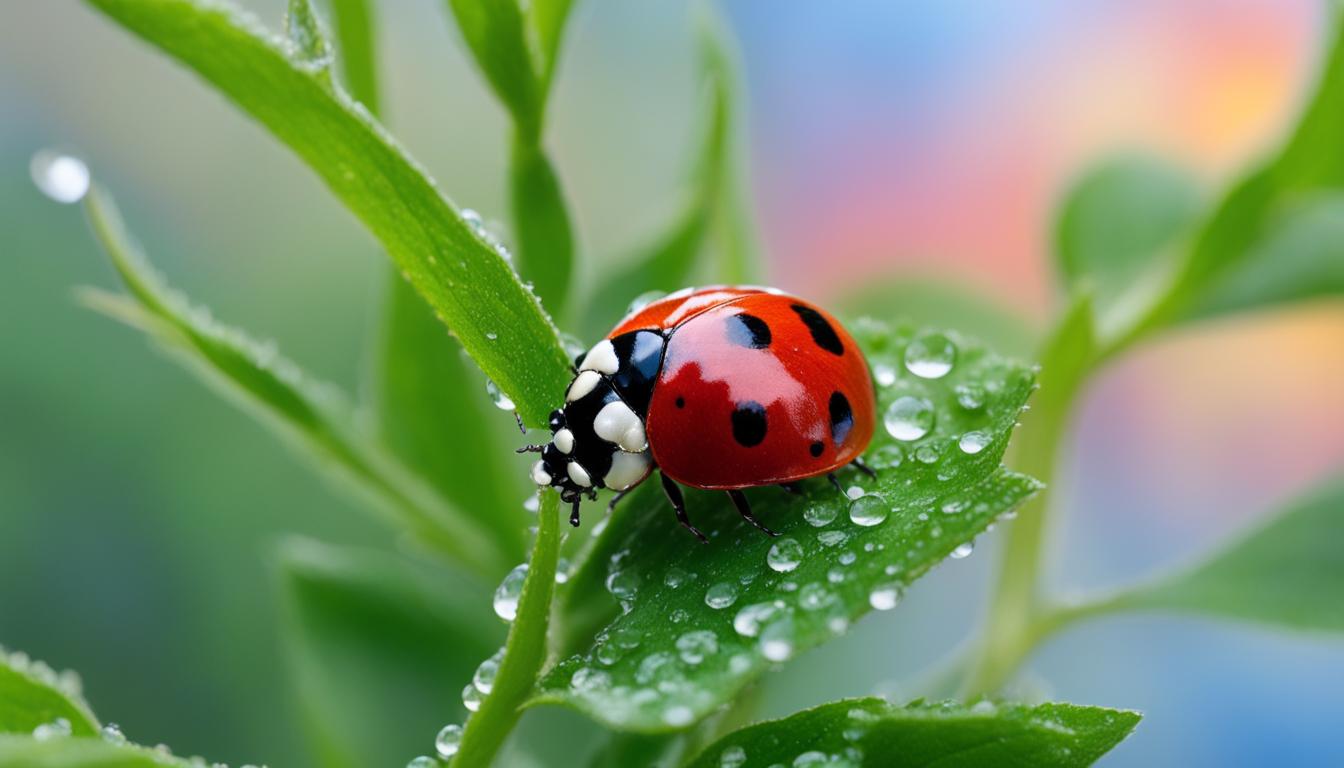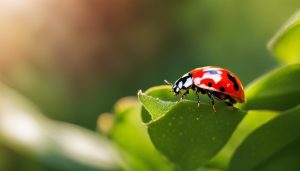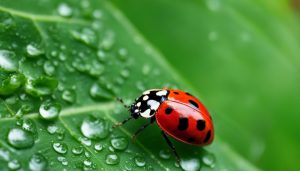Have you ever wondered if putting a ladybug outside can bring you good luck? Ladybugs have been revered as symbols of luck in many cultures throughout history. From predicting the number of years of good fortune based on their spots to being seen as omens of love, these delightful insects have captured our imagination and held a special place in our hearts.
Ladybugs have earned their status as icons of good luck due to their role as natural pest controllers. Whether in farming or gardening, these tiny creatures help keep plants healthy by feasting on harmful pests, without the need for harmful pesticides. By releasing ladybugs into your garden, you not only invite good luck into your life but also contribute to the preservation of these beneficial insects and create a thriving ecosystem.
Contents
- 1 The Symbolism of Ladybugs Around the World
- 2 Releasing Ladybugs: Benefits for Your Garden and the Environment
- 3 How to Release Ladybugs in Your Garden
- 4 Ladybug Conservation and Importance
- 5 Conclusion
- 6 FAQ
- 6.1 Is it good luck to put a ladybug outside?
- 6.2 What is the symbolism of ladybugs around the world?
- 6.3 What are the benefits of releasing ladybugs in your garden?
- 6.4 How do you release ladybugs in your garden?
- 6.5 What are organic pest control methods and how do they relate to ladybugs?
- 6.6 Why are ladybugs important for conservation?
- 7 Source Links
Key Takeaways:
- Ladybugs are regarded as symbols of good luck in various cultures.
- They have a long-standing association with predicting fortune based on their spots.
- Ladybugs are natural pest controllers, protecting crops without harmful pesticides.
- Releasing ladybugs can contribute to ladybug conservation and a healthy ecosystem.
- Embracing ladybugs can bring luck, love, and environmental stewardship into your life.
The Symbolism of Ladybugs Around the World
Ladybugs are universally recognized as symbols of positivity, love, and good fortune. Across cultures, these charming insects have been associated with various beliefs and legends that highlight their symbolic significance. From granting wishes to protecting babies, ladybugs hold a special place in the folklore and mythology of many societies.
One prevalent belief is that ladybugs bring luck and prosperity. In some cultures, the number of spots on a ladybug’s back is believed to indicate the duration of good luck that awaits an individual. Additionally, ladybugs have been associated with love and relationships, with the belief that finding a ladybug on oneself signifies the presence of true love.
Ladybugs also have a practical significance. Farmers have long regarded ladybugs as omens of a bountiful harvest. These small creatures play a crucial role in pest control, feeding on aphids and other harmful insects that can damage crops. Their presence in gardens and fields helps maintain a healthy ecosystem and reduces the need for harmful pesticides. Ladybugs’ vibrant colors and distinctive spots serve as a warning to predators, communicating their distastefulness or even toxicity.
| Symbolism | Ladybug Facts |
|---|---|
| Love and Relationships | Ladybug folklore suggests that finding a ladybug on yourself is a sign of true love. |
| Luck and Prosperity | The number of spots on a ladybug’s back is believed to predict the duration of good luck. |
| Protection | Ladybugs are seen as protectors of babies and are believed to bring safety to travelers. |
| Pest Control | Ladybugs help control aphid populations, protecting plants and crops without the need for pesticides. |
Ladybugs, with their rich symbolism and practical benefits, continue to capture our imagination and remind us of the beauty and interconnectedness of nature.
Ladybug Folklore
“When a ladybug lands on you, make a wish and it will come true.” – Anonymous
Ladybug folklore reflects the reverence and admiration people have for these tiny creatures. For centuries, ladybugs have been thought to possess magical qualities. In some cultures, it is believed that if a ladybug lands on you, you should make a wish, and that wish will come true. Ladybugs are also associated with protection. Some legends suggest that if a ladybug lands on a baby, it brings health and happiness. Similarly, the sight of a ladybug before embarking on a journey is seen as a symbol of protection, ensuring a safe and fortuitous trip.
The Ladybug’s Natural Defense
Ladybugs’ striking colors and patterns not only lend them aesthetic appeal but also serve as a defense mechanism. The bright red or orange coloration, accompanied by contrasting black spots, serves as a warning to potential predators. Ladybugs emit a foul-smelling fluid when threatened, discouraging predators from consuming them. Some species of ladybugs even have toxic compounds in their bodies, further deterring would-be attackers.
Releasing Ladybugs: Benefits for Your Garden and the Environment
Releasing ladybugs in your garden can offer numerous advantages for both your garden and the environment. By utilizing these eco-friendly pest controllers, you can enjoy the benefits of natural pest control without the use of harmful chemicals. Ladybugs are natural predators of aphids and other plant-damaging insects, making them an effective and sustainable alternative to chemical pesticides.
In addition to their pest control abilities, releasing ladybugs can also contribute to the conservation of these beneficial insects. Ladybugs face threats from habitat loss, pesticide use, and competition from invasive species. By releasing ladybugs, you can help maintain their population and ensure their presence in ecosystems.
Table: Benefits of Releasing Ladybugs
| Benefits | Explanation |
|---|---|
| Eco-friendly pest control | Ladybugs consume plant-damaging insects, reducing the need for chemical pesticides. |
| Conservation of ladybug population | Releasing ladybugs helps maintain their population and ensures their presence in ecosystems. |
| Promotes garden health | Ladybugs keep pest populations in check, allowing your plants to thrive. |
Releasing ladybugs is a simple process that can make a significant impact on your garden and the environment. By following the right steps and considering the optimal conditions for release, you can maximize the effectiveness of these natural pest controllers. Avoid releasing ladybugs directly into areas treated with harmful pesticides or under direct sunlight, as it may harm them.
By incorporating ladybug gardening practices into your routine, you can contribute to a healthier and more balanced ecosystem, while also enjoying the benefits of a pest-free garden.
How to Release Ladybugs in Your Garden
Releasing ladybugs in your garden is a simple and effective way to enhance natural pest control. Here’s a step-by-step guide on how to release these beneficial insects and create a ladybug-friendly environment in your garden.
Choose the Right Time and Location
Pick a time of day when the temperature is mild and the sun is not too hot, such as early morning or late afternoon. This ensures that the ladybugs will have a comfortable environment to settle into. Before releasing the ladybugs, make sure to lightly mist the area with water. This provides them with a source of hydration and encourages them to stay in your garden.
Open the Container
Gently open the container that holds the ladybugs. It’s important to handle them with care to avoid harming them. Once the container is open, sprinkle the ladybugs onto the plants or near areas where pests are present. This allows them to easily find their food source and establish their presence in your garden.
Avoid Harmful Conditions
When releasing ladybugs, it’s crucial to avoid exposing them to direct sunlight or areas treated with harmful pesticides. Ladybugs thrive in shaded areas and their presence is essential for organic pest control. By releasing them away from harmful conditions, you give them the best chance to thrive and fulfill their role as natural pest controllers.
Remember, ladybugs are beneficial insects that contribute to the health of your garden ecosystem. By following these simple steps, you can release ladybugs in a way that maximizes their impact and ensures a thriving garden environment.
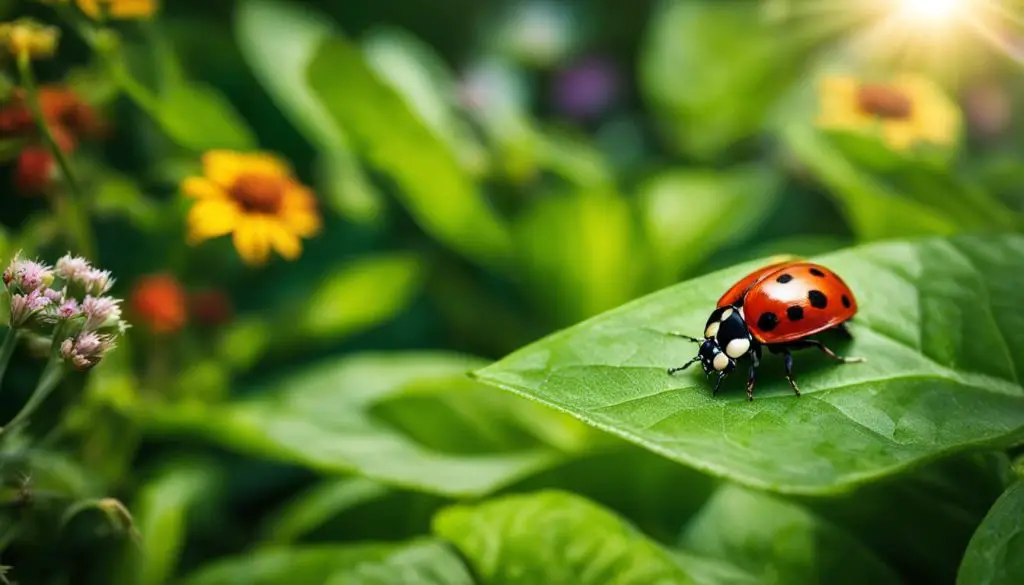
How to Attract Ladybugs to Your Garden
Creating a ladybug-friendly habitat is key to attracting and retaining these beneficial insects. Ladybugs are attracted to certain plants, such as dill, fennel, and yarrow, which can serve as companion plants in your garden. Planting a diverse range of flowering plants that provide nectar and pollen throughout the growing season will also help entice ladybugs to stay.
| Companion Plants | Attracting Ladybugs |
|---|---|
| Dill | Produces nectar and pollen |
| Fennel | Irresistible to ladybugs |
| Yarrow | Provides a food source for adults and larvae |
Integrated Pest Management with Ladybugs
Ladybugs are a vital part of an integrated pest management (IPM) strategy. IPM combines various pest control techniques to manage pests effectively while minimizing environmental impacts. By incorporating ladybugs into your IPM approach, you can use fewer chemical pesticides and rely on these organic pest control agents for long-term results. Remember to practice crop rotation, maintain plant diversity, and monitor pest populations to ensure a healthy and balanced garden ecosystem.
Ladybug Conservation and Importance
In addition to their symbolism and role in natural pest control, ladybugs play a crucial role in maintaining the overall health of ecosystems. These small insects have a voracious appetite for pests like aphids, mites, and scale insects, helping to protect plants, crops, and gardens from infestations and damage. By consuming large numbers of these harmful insects, ladybugs help to keep the natural balance in check.
Ladybugs are also vital pollinators, aiding in the reproduction of many flowering plants. As they move from flower to flower in search of food, they inadvertently transfer pollen, facilitating the fertilization process. This promotes the growth and diversity of plant species, contributing to a vibrant and thriving natural environment.
“Ladybugs are not just pretty insects; they are an essential part of our ecosystems. By conserving and protecting their populations, we are ensuring the health and sustainability of our natural world.”
However, some species of ladybugs are facing threats to their survival. Native ladybug populations in North America, for example, are experiencing habitat loss, pesticide use, and competition from invasive species like the Asian lady beetle. It is crucial to support ladybug conservation efforts to preserve these beneficial insects for future generations.
| Threats to Ladybug Conservation | Ways to Support Ladybug Conservation |
|---|---|
| Habitat loss due to urbanization and deforestation | Create ladybug-friendly habitats in gardens and protected areas |
| Pesticide use in agriculture and gardening | Avoid or minimize the use of harmful pesticides |
| Competition from invasive ladybug species | Monitor and manage invasive species populations |
| Lack of awareness about the importance of ladybugs | Educate others about the benefits of ladybugs and their conservation |
By taking these proactive measures, we can safeguard ladybug populations and ensure their continued presence in our ecosystems. Ladybugs are not only charming creatures but also vital contributors to the health and balance of our natural world. Let’s do our part to protect and conserve these wonderful insects!
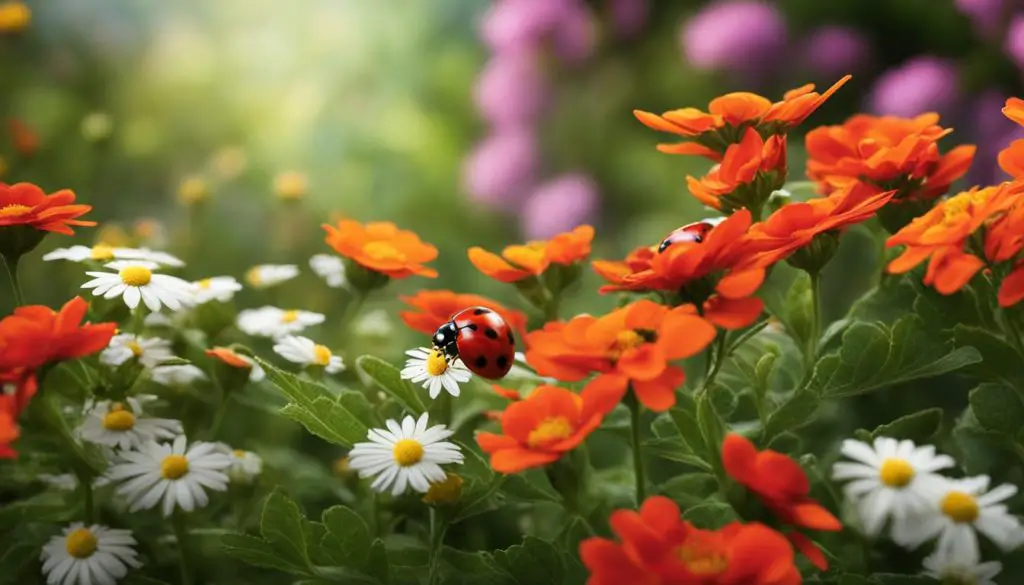
Conclusion
Ladybugs have long been revered in many cultures for their beneficial qualities, including their association with good luck and symbolism of love and prosperity. Releasing ladybugs in your garden not only brings good fortune but also provides a natural pest control solution, contributing to a healthy and thriving ecosystem.
By understanding the importance of ladybug conservation, we can help protect these beneficial insects from threats such as habitat loss and pesticide use. Supporting ladybug conservation efforts, such as creating ladybug-friendly habitats and promoting native plants, ensures the preservation of these valuable creatures for future generations.
Embracing the legend and symbolism of ladybugs, we can appreciate their role as natural pest controllers and environmental stewards. So, the next time you spot a ladybug, remember that it represents not only luck but also an opportunity to contribute to the conservation of these remarkable creatures and embrace the beauty of a balanced ecosystem.
FAQ
Is it good luck to put a ladybug outside?
Ladybugs are historically believed to be talismans of luck in many cultures. They are associated with symbols of good fortune, such as predicting the number of years or months of good luck based on the number of spots on a ladybug. Some folklore even suggests that a ladybug landing on you can bring true love.
What is the symbolism of ladybugs around the world?
Ladybugs are seen as positive influences in cultures around the world. They are often associated with love, prosperity, and good luck. In mythology and folklore, ladybugs are believed to grant wishes, protect babies, and provide safety for travelers.
What are the benefits of releasing ladybugs in your garden?
Releasing ladybugs in your garden can offer several benefits. Ladybugs are natural predators of aphids and other plant-damaging insects, making them an eco-friendly alternative to chemical pesticides. By releasing ladybugs, you contribute to a natural pest control method that is safe for plants, animals, and the environment.
How do you release ladybugs in your garden?
Releasing ladybugs in your garden is a simple process. Start by choosing a time of day when the temperature is mild and the sun is not too hot, such as early morning or late afternoon. Before releasing the ladybugs, lightly mist the area with water to provide them with a source of hydration. Gently open the container and sprinkle the ladybugs onto the plants or near areas where pests are present.
What are organic pest control methods and how do they relate to ladybugs?
Ladybugs are an important component of organic pest control methods. They are nature’s own pest control experts, capable of consuming large numbers of plant-damaging insects like aphids, mites, and scale insects. By encouraging ladybug populations in your garden through habitat preservation and release, you can reduce the need for chemical pesticides.
Why are ladybugs important for conservation?
Ladybugs play a crucial role in maintaining the health of ecosystems. Their voracious appetite for pests helps to protect plants, crops, and gardens from infestations and damage. Ladybugs are also vital pollinators, aiding in the reproduction of many flowering plants. However, some species of ladybugs face threats from habitat loss, pesticide use, and competition from invasive species. Supporting ladybug conservation efforts can help preserve these beneficial insects for future generations.

